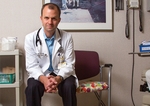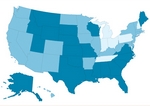health
Unequal distribution of doctors hurts children's medical care
■ Millions of young patients lack access to care because physicians who treat them tend to gravitate to urban areas, a new study says.
By Carolyne Krupa — Posted Feb. 1, 2011
- WITH THIS STORY:
- » Related content
The nation's pediatricians and family physicians who care for young patients are clustered primarily in large cities, leaving many small communities devoid of doctors to care for their children, a new study says.
In an analysis of where such physicians practice nationwide, researchers determined that there are enough doctors to care for U.S. children, if only they were more evenly distributed.
"The evidence is very strong that we have an adequate physician work force for children," said pediatrician Scott A. Shipman, MD, MPH, lead study author and assistant professor at the Dartmouth Institute for Health Policy and Clinical Practice. "The [child] population isn't growing that much. The problem there really is maldistribution."
The number of general pediatricians grew 51% to 38,981 between 1996 and 2006, and the number of family physicians increased 35% to 83,081. Meanwhile, the number of U.S. children grew by just 9% to 73.7 million, according to the study published in the January issue of Pediatrics (link).
Still, millions of U.S. children have trouble accessing care, Dr. Shipman said.
In 2006, 15 million children lived in areas with more than 4,400 children for every physician who treats them. Nearly 1 million children in 47 states lived in areas with no local physician for children.
By contrast, 20% of children lived in high-supply areas with an average of 141 physicians per 100,000 children, said the study, which analyzed American Medical Association Physician Masterfile data.
"The maldistribution problem is intense," said Brock Slabach, MPH, senior vice president for member services at the National Rural Health Assn.
Rural medicine incentives lacking
Several factors make it difficult to attract physicians to underserved areas. People who live in rural communities often are poorer and lack health insurance, making those areas unattractive to physicians graduating from medical school with a lot of debt, Slabach said.
Doctors with families may opt to live in cities for access to better schools, amenities and a more robust job market for a working spouse, Dr. Shipman said. The majority of pediatricians and a growing proportion of family physicians are women, who are more likely to practice in highly populated areas, the study said.
Another issue is that most medical schools and residency programs are in cities, so young physicians may never be exposed to rural practice, Dr. Shipman said. Although medical students from rural communities are more likely to practice in those areas after graduation, many medical schools don't take a rural background into consideration as part of admissions.
"We've magnified the problem by who we're bringing into medical school, who we're training and how we're training them," he said.
But the study doesn't take into consideration some important factors affecting physician access, said Atul Grover, MD, PhD, chief advocacy officer for the Assn. of American Medical Colleges. The AMA Masterfile includes physicians who work part time, making it difficult to determine access by the number of physicians in an area.
In addition, many physicians who work in urban areas are at academic medical centers, meaning their time is split among practice, teaching and research. "Only one part of access is counting bodies," Dr. Grover said.
The study emphasizes a need to focus on ensuring that physicians are distributed better, rather than simply training more physicians. Some medical schools already are working to attract students from rural areas and minorities who have shown a predisposition to practice in underserved populations, Slabach said. The health system reform law also includes money for rural physician training programs.
More incentives, such as loan repayment programs and scholarships, are needed to attract students to underserved areas, Dr. Shipman said.
"Just training more doctors is not going to change the ability for there to be equitable access to care for anyone," he said.












